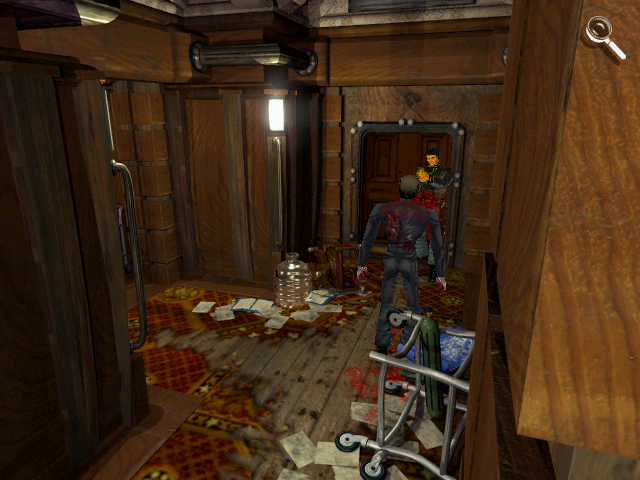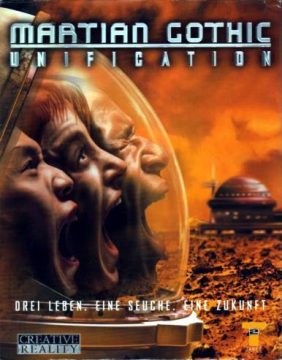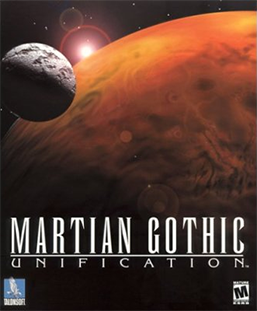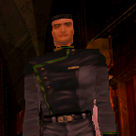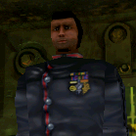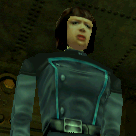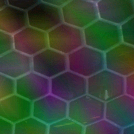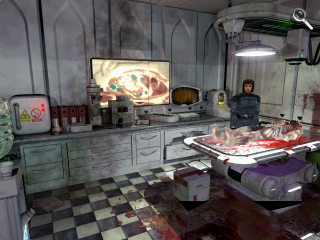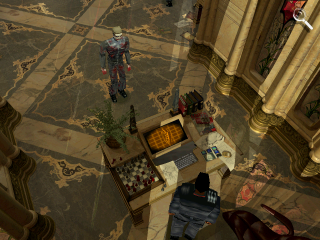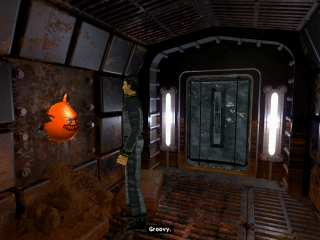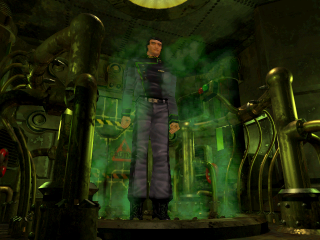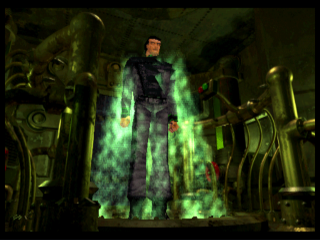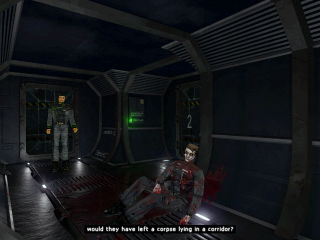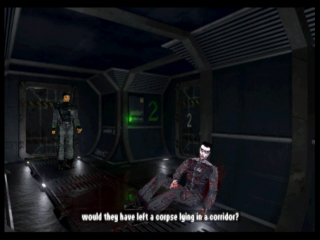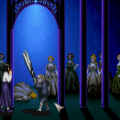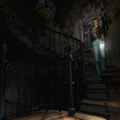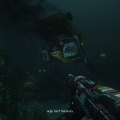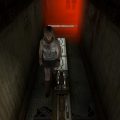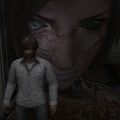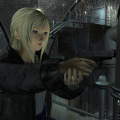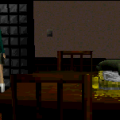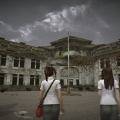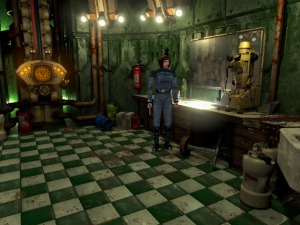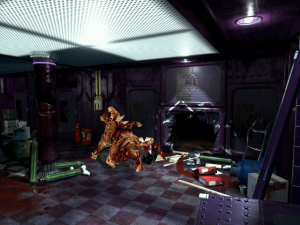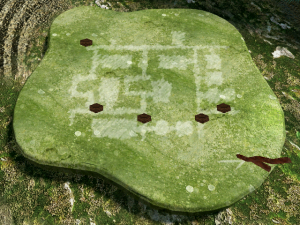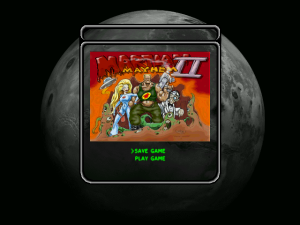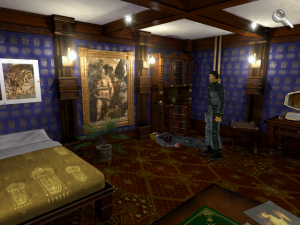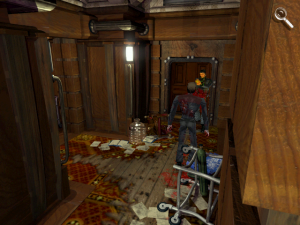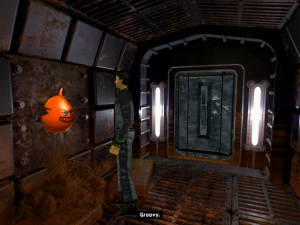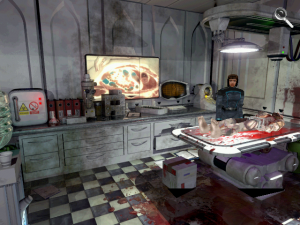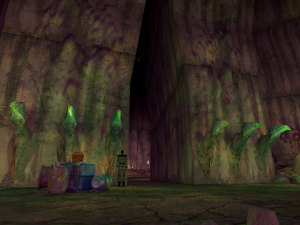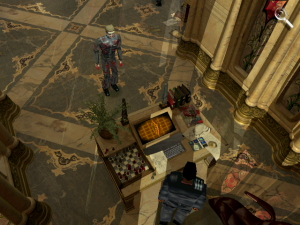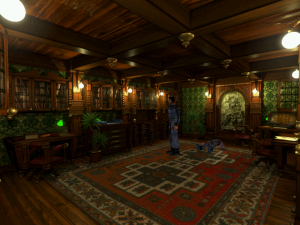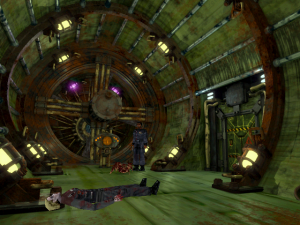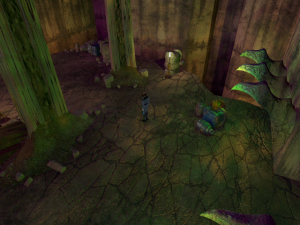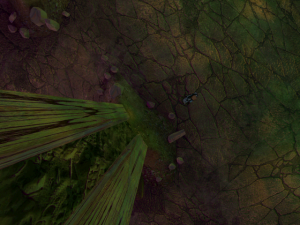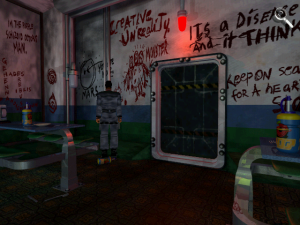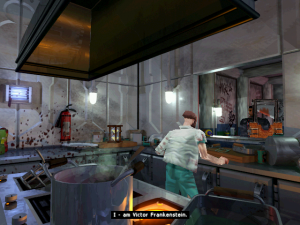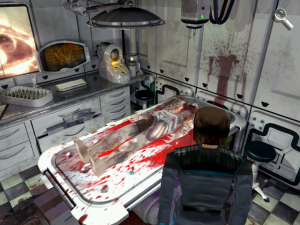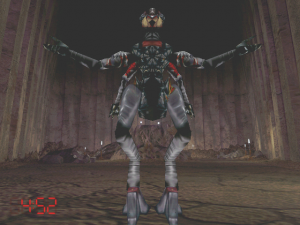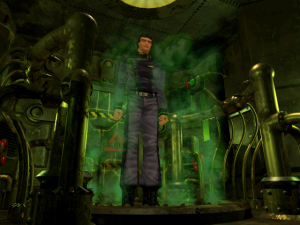Martian Gothic : Unification is one of the numerous titles which came out at the end of the PlayStation lifespan. At first glance, it looks like a typical Resident Evil rip-off with a futuristic paint, a disturbing cover and bad voice-acting. Of course, the game ended up selling very poorly. But it’s so much more than that. Incidentally, it is also Creative Reality’s last game. Sharing the same team and the same writer than Dreamweb, it comes as no surprise that the game heavily relies on writing and puzzles. This reliance (and a few more things) makes Martian Gothic: Unification a title to look back at.
“Stay alone, stay alive” – this was the last communication of Vita-01 base, the first human settlement on Mars. Ten months after receiving this message, the Allenby Corporation sends a team of three experts to investigate the meaning of the message. Everything quickly goes from bad to worse: the space shuttle crash-lands, forcing the trio to reach Vita-01 base through three different airlocks. During the introduction, the base A.I called MOOD predicts that only two of them will leave Mars alive. The decontamination process feels ‘very wrong’ to each of the three characters, suggesting the presence of a bacterial agent in the gas. Trying to restart most of the base functions, Kenzo is the first to venture into the base. Silence has fallen upon Vita-01 base and the corridors are full of staff corpses. Apparently, some committed suicide, while others were gunned down. Strangely enough, all the corpses are frozen, even though the station temperature remains steady. As soon as Kenzo suceeds in unlocking the doors, the “non-dead” (a name given to them by the trio) awake from their slumber and start attacking him. As the team goes on, it soon becomes clear that the excavation of a Martian artefact dubbed “Pandora’s box” is the root of all this horror. Even worse, one can hear an alien presence throughout the base. To solve the mysteries of the Martian base and escape it, you will need a lot of time, wits and patience.
Separated by chance, the team will soon understand how lucky they are. Indeed, the tagline ‘stay alone, stay alive’ refers to the strange alien agent in the air. If, two of the characters were to be close to each other, they would be compelled to reach the third character and turn into a grotesque creature called Trimorph. Gameplay-wise, putting two characters in the same room will result in instant game over 95% of the time. One of the long term goals is to find a vaccine against the alien chemical agent, so late in the game you might even be able to bring the characters together.
Characters
Kenzo Uji
Self-describing himself as a ‘techno-zen hippy,’ he is the info-mesh specialist, a virtual man-machine interface. Therefore, he is the only one who can fully interact with MOOD. Despite the dire situation on Vita-01 base, he remains an extremely calm and detached person. Kenzo is the first to reach MOOD’s chamber and find access cards for Martin. Later on, he spends most of his time in the infomesh reality to manage the base systems. He is the only one who can use the Psionarra, an experimental psychic gun found late in the game. Thanks to his strange occupation, Kenzo never shows any sign of emotion and has the weirdest one-liners. His genuine Japanese voice actor is also the source of many laughs but to his credit, he wasn’t even a professional.
Martin Karnes
The team’s security expert. An ex-covert ops agent and former friend of Allenby. His son died during a tragic accident. A natural leader, he is the one who gives most of the objectives to the rest of the team. Contrary to the others, he signed up for personal reasons. There are a lot of shady secrets about this guy. Exploring the Vita-base will allow you to unearth most of them. Martin acts all cynically and cracks pretty grim jokes. Even if he doesn’t have any “special” skill (anyone can use a gun), he solves countless puzzles.
Diane Matlock
A microbiologist, acting as the scientific expert in the team. She hides her fear behind a happy-go-lucky attitude. She is the most knowledgeable about the Vita-01 base and its crew, making regular comments about the past lives of corpses and non-deads. Diane is very useful once you reach the lab section. She can synthesize health kits and antidotes from herbs with the proper equipment. Unfortunately, she starts the game trapped in her own airlock. It takes a few hours to get her out.
Mood
Voiced by relatively well-known Fenella Fielfing (the village announcer in The Prisoner!), she is a sentient infomesh, in charge of handling Vita-01’s massive network systems. As an A.I, MOOD only appears as a rainbow-like wall materializing sound-waves. In direct response to the grim events taking place in her base, she locked most of the blastdoors. Kenzo will have to get on her good side to open them. He can access her mainframe through a virtual representation of his own home, a traditional japanese house. MOOD is always teasing the characters and the player, especially during Game Over screens. For an unknown reason, she deeply resents Karnes.
The game heavily borrows from Resident Evil; third-person perspective, fixed angle camera, tank controls and colored key-cards by the dozen. Contrary to Capcom series, it focuses much more on puzzles and exploration than combat. Fighting is present, with various kind of futuristic firearms and even a psychic gun, but is mostly used for crowd-control or dispatching small-fry. It’s also ridiculously easy to be overwhelmed by enemies, as non-dead walk at the exact same pace as the player characters. Like Day of the Tentacle, the entire game revolves around the separated trio gimmick. At any moment, you can switch to the other characters. Communication is made easy by radio but you can only pick up a limited number of items in your inventory. Fortunately, the base is filled with “vac-tubes” to exchange items. Send a keycard or gun through the system and anyone can get them through their nearby vac-tube. Watch out though; switching characters does not freeze time for the rest of the team, leaving them unprotected. Don’t forget to look for a safe spot before swapping.
There are only three types of enemies in Martian Gothic:
- Non-dead : The most common threat. A zombie reanimated by the alien presence. They awake when someone walks near their corpses. They cannot be killed permanently, therefore the trick is to lure them in a dead end and shoot them down. They will never bother you there. Be careful though, the more the game progresses, the faster the non-dead raise after being shot down. You need to incapacitate every non-dead you encounter at least once, because they all carry recovery items, logs and puzzle items. If you’re caught by one of them, simply tap directional keys very fast, you might even get away with no damage at all!
- Extrudes : Annoying little creepers who can easily overwhelm you. They come in three different versions, each having a different colour. They can all can jump at your face, either spitting poison or paralyzing you. Fortunately, a single nail gun shot followed by a kick kills them.
- Trimorphs: The origin of the “stay alone, stay alive” tagline. These hulking brutes cannot be killed through normal procedure. You always have to solve a puzzle in order to dispose of them. Needless to say, they are pretty deadly.
Computers are extremely important in Martian Gothic: Unification, giving you access to clues, passwords and much more. From time to time, voice recognition is required to unlock them, so try to locate the recorded voice logs scattered around. They can also be used to gather background information and NOT play “Martian Mayhem,” “the worst game of all time” according to the manual. The mini game was scrapped due to deadlines. It now serves as an excuse for limited save points (usually 2 up to 4 times in the PC version and 12 times on PlayStation). Once you reach the necropolis, the excavation site, you will find a laptop, which allows to save anywhere. Since the last area of the game is a maze, it’s a precious boon.
In terms of quality, Martian Gothic: Unification‘s aesthetics are a mixed bag. The 2D backgrounds are very detailed and impressive for the small team size (6 persons + external concept artists like famous illustrator Kev Walker). The Vita base never feels just like an endless corridor of metallic grey and rusty brown. The R&R sections feel very comfy with their oak-panelled interiors. Many corridors give you a full view of the Martian landscape, and so on. Unfortunately, the 3D models are kind of dissapointing. The characters are all really blocky and look mostly the same. Enemy and weapon design feel pretty lackluster too.
Martian Gothic: Unification‘s greatest strength lies within its writing. Stephen Marley, already responsible for the script of Dreamweb, created a solid horror science-fiction plot. Even if the voice-acting is a mixed-bag, the dialogues are top-notch. Characters’ distinct personalities emerge through the sheer description of items and places. Revisiting a place with a different character always give you a new twist on things. As expected, the humour tends to be pretty dark. The mass of background information available on the Vita base project, the Allenby Corporation and the alien activity is massive and really a good read. The plot unfolds at a slow pace, taking its time to flesh out the characters, their agenda and of course the Martian menace itself.
The level design is fairly well done. It’s very reminiscent of the first Alone in the Dark. A gigantic complex, with many areas available from the get go, many puzzles to solve at the same time, in whichever way you want. Once the areas have been fully opened up and the mystery lifted, you can reach the final excavation site under the base to take care of the problem and eventually escape. Unnerving at first, navigation rapidly becomes a breeze. A nice idea was to name all the corridors of the vita base with famous street names: Broadway, Mont St-Michel, etc. It’s much easier to navigate with those names in mind.
As explained before, puzzles are incredibly important for the game, maybe too important. According to an interview with Marley, the game was conceived as a point & click and scrapped later on for the more profitable survival-horror approach. It really makes sense looking at the sheer number of inventory-based puzzles. Most of them are well-thought out and interesting, like escaping a trimorph by shoving him through an airlock. But a few are annoying and awful. The first problem lies within the survival-horror genre conventions. Since your inventory is limited and puzzles usually involve many items, you end up spending most of your time walking back and forth around the vita tubes. This issue is accentuated by all the survival stuff you need: guns, ammo, keycards, medkits, etc. Another problem, perhaps the most infuriating, is caused by the many useless items. Nicotine patchs and other such items without any purpose are scattered throughout the game.
Otherwise, the survival-horror part is decent. Fighting sensations are a bit stiff: all the guns look and feel the same and enemies tend to be bullet-sponges. On the other hand, the atmosphere never lets go, with a brilliant use of sound, especially the alien presence emitting eerie sounds and twisted whispers through the entire base. Apart from the creepy main menu theme, music is barely noticeable, consisting of creepy ambient sounds. Corpses are scattered around the base, not only the undead kind. Hanged men and bullet-filled women usually have magnetic recorders on them, giving you a clearer understanding of the story. Martian Gothic: Unification is quite verbose, a bit too much sometimes. The final recordings usually last for two or three minutes each, and there are a lot of those.
The PlayStation port is actually pretty good. The technical downgrade is nearly nonexistant, apart from the lower resolution and noticeable slowdowns when switching between characters. This version of the game is easier, too, allowing to save more often and giving out much more recovery items along the way. Some puzzles, like the Kremlin room, have been simplified and an annoying type of extrudes was purely sketched off. Other than that, differences between the two versions are minor.
(On a more trivial note, I encountered a bug at the end of the game. In the Necropolis, extrudes kept on respawning ever and ever, making it impossible for me to clear this part of the game. A batch of saves from a different playthrough allowed me to succeed, though. By checking message boards, Martian Gothic: Unification appears to have a few deadly bugs. Therefore, don’t forget to save on different files.)
As said before, Creative Reality had a very small team working on Martian Gothic: Unification. They also had a very tight time schedule to conduct the project. Last but not least, they had to take care of versions for two platforms. In the end, many things were swept aside: the showdown with a final boss, a NPC giving you hints to solve puzzles (you can still find his radio in the PC version). Perhaps the saddest cut was the possibility to choose who would live and who would die at the end of the game. Still, in the face of adversity and grotesque obstacles, Creative Reality made an excellent job. Unfortunately, the game bombed and the England-based studio closed.
Links:
Retroaction Interview with Stephen Marley, writer of Martian Gothic
